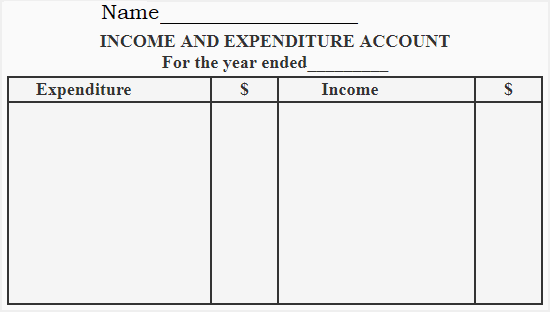An income and expenditure account is an account revealing the surplus or deficit of a non-trading concern, which involves matching incomes and expenses over a specified accounting period. An income end expenditure account is simply another name for the expense and revenue summary of a non-trading concern. This is prepared on the lines of expense and revenue summary. All incomes received from receivables and all expenses paid or payable are accounted for at the end of the period it covers. An income and expenditure account only includes revenue expenses and income. It does not include capital expenditure and income, and it excludes all items in respect of the previous or subsequent period. The income and expenditure account is the final account for a non-profit organization. The final account of a business enterprise is called a trading and profit and loss account, while in the case of a non-trading enterprise, it is known as an income and expenditure account. Given that non-trading organizations cannot prepare profit and loss accounts (i.e., as they do not operate to earn profits), the final account shows either a surplus or deficit. The following are the main features of a non-trading organization's income and expenditure account: Similar to any other account, there are two columns in an income and expenditure account: one is on the debit side (named expenditure) and the other is on the credit side (named income). These two columns are used to record all the expenditures and revenues of a non-trading organization over a specific accounting period (usually one year). The format/specimen of an income and expenditure account is shown below. It is possible to prepare an income and expenditure account in any of the following forms: If the account is prepared in account form, it is called an income and expense account. All expenditure items appear on the debit side and income items appear on the credit side. If the debit side (expenditure) exceeds the credit side (income), it is classed as deficit balance; if the credit side exceeds the debit side, it is a surplus balance. If the account is prepared in report form, it is called an income and expenditure summary statement. In this form, all incomes are recorded first and then all expenditures are recorded. The balance of the income and expenditure account is ascertained. If income exceeds expenditure, there is a surplus balance (or excess of income over expenditure). If expenditure exceeds income, this is a deficit balance (or excess of expenditure over income). The balance of income and expenditure account is transferred to the balance sheet. Surplus balance is added to the accumulated fund (capital) and deficit balance is deducted from the accumulated fund. Deficit balance can also be shown as an asset on the balance sheet. This link provides detailed examples of how to prepare an income and expenditure account from a receipts and payments account.Definition
Explanation
Features of Income and Expenditure Account
Format/Specimen of Income and Expenditure Account

Preparation of Income and Expenditure Account
Account Form
Report Form
Examples
Income and Expenditure Account FAQs
A trading account shows the profit or loss of an enterprise. It consists of two parts: receipts and payments account, which shows all receipts from sales or services rendered by the business entity, as well as all expenses paid for these transactions; and a trading account, where the difference between the total of receipts and payments is shown.
An income and expenditure account can be prepared in any of the following forms: account form, report form or computerized form. However, it should show all incomes on the credit side and all expenditures on the debit side. If the debit side (expenditure) exceeds the credit side (income), it is classed as deficit balance; if the credit side exceeds the debit side, it is a surplus balance.
A balance sheet summarizes an entity's financial position at a point in time by expressing assets, liabilities and capital (accumulated fund/capital) as a single amount.
Profit and loss is the measure of total revenue less all expenses for a given period of profit measures the increase in the value of an entity, while loss measures its decrease in value. Profit can be measured either before or after tax; if it is measured before tax, it is called profit available to equity holders. If it is measured after tax, it is called net profit and is available to creditors and owners.
Revenue or turnover is the total value of all final goods and services produced within an economy over a given period of time, such as yearly or monthly income is one aspect of financial flow. The other aspects are capital expenditures, depreciation and withdrawal of funds.
True Tamplin is a published author, public speaker, CEO of UpDigital, and founder of Finance Strategists.
True is a Certified Educator in Personal Finance (CEPF®), author of The Handy Financial Ratios Guide, a member of the Society for Advancing Business Editing and Writing, contributes to his financial education site, Finance Strategists, and has spoken to various financial communities such as the CFA Institute, as well as university students like his Alma mater, Biola University, where he received a bachelor of science in business and data analytics.
To learn more about True, visit his personal website or view his author profiles on Amazon, Nasdaq and Forbes.











